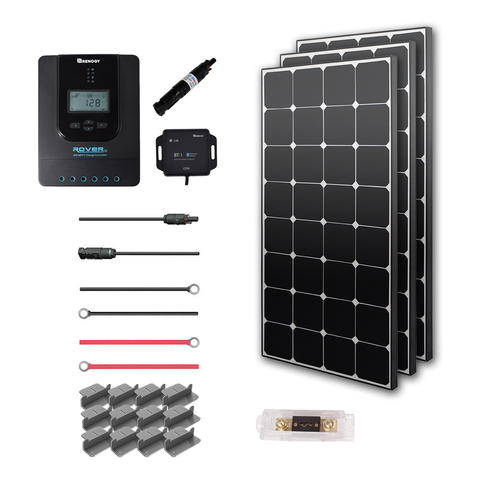Making Solar Work for Tiny Homes

Tiny homes are all the rage lately. You see them on the road, near campsites, and perhaps most often on large plots of land. All are generally less than 1000 square feet, while some are as small as 100 square feet. No matter what size, these tiny homes are newly built and ready to be planted. The media points to a lack of affordable housing and an aging American population as catalysts of the tiny home movement. Tiny homes, of course, are less expensive to purchase and generally require less power than regular homes, or even traditional manufactured homes. The lower price points and lack of maintenance make them an attractive option to young people on a strict budget, as well as retirees. Contributing further to the tiny home movement is the current housing boom, which has been driving up home prices. As usual, the market responded to skyrocketing real estate prices with tiny (and more affordable) solutions.
It is no surprise that tiny homes are most popular in regions where housing prices have recently soared. Take for example, metro areas such as Denver, CO, where the median home price is now $405,000. As is the case in most areas, wages have not kept up with housing increases, making it difficult for young adults and retirees alike, to afford quality housing. That’s where tiny homes come to the rescue. Many are constructed with sustainable materials, excellent insulation, and solar panels. This helps keep maintenance and power costs low. Since they are smaller, they also require less electricity overall. Perhaps the best part of all is the fact that they can be parked just about wherever zoning and city ordinances allow! That means if you get tired of living in one area, you can simply pick up and move your home to another. This works out wonderfully for those who like to travel or get bored easily.
Keeping in line with their sustainable nature, many tiny homes have solar incorporated into their design. For those that do not include built-in panels, many often decide to add them later. If the tiny home will be placed in an area with no electrical hookups, a generator or solar power system will necessary to power appliances and lights. Solar is typically the preferable option, as it only relies on sunlight to recharge the battery bank.
Renogy sells a variety of solar kits that are perfect for tiny homes. Our kits are pre-designed to include most of the products you will need to construct an entire off-grid power system (less the battery bank). Since tiny homes are designed to be year-round living quarters, you will need a dependable, high efficiency system. For tiny homes, or even sheds and cabins, Renogy recommends the Premium Kit. Each Premium Kit includes one or more high efficiency Eclipse Monocrystalline Solar Panel(s). The Eclipse Panels have an efficiency rate of 18.35%, while standard Renogy Monocrystalline Solar Panels have an efficiency rate of 15.47%. The Eclipse Panels include an ultra-sleek black frame and are smaller in size than their standard counterparts, making them an ideal choice for the demands of tiny home living.

Each Premium Kit also includes a Rover Li 40A MPPT Charge Controller. Unlike standard PWM charge controllers, this controller utilizes Maximum Power Point Tracking technology, with high tracking efficiency up to 99% and peak conversion efficiency of 98%. It is capable of self-diagnosing system errors and can communicate with the Renogy BT-1 Bluetooth Module. With the Bluetooth Module, you can monitor and track system performance on your phone through the Renogy smartphone app. Due to the everyday need for the solar power system to be running on a tiny home, a dependable charge controller is absolutely necessary.
As stated above, each Premium Kit comes with the wiring necessary to put together the power system, as well as the mounting brackets and Bluetooth module. The mounting Z-Brackets are constructed out of high-quality aluminum that is resistant to the elements. However, one should keep in mind that these Z-Brackets are best used with a user-made structure, such as a wooden frame and will not be appropriate for a shingle/composite roof. If mounting directly onto a tiny home roof, traditional roof mounts will be necessary to prevent leakage and ensure long term performance.
In sum, the Renogy Premium Kit is the high-efficiency workhorse you are looking for to complete your tiny home journey. You can choose the system size that meets your needs without completely breaking the bank. You can also be sure that the system will work even in low light conditions. To read more, visit the Premium Kit page: https://www.renogy.com/











